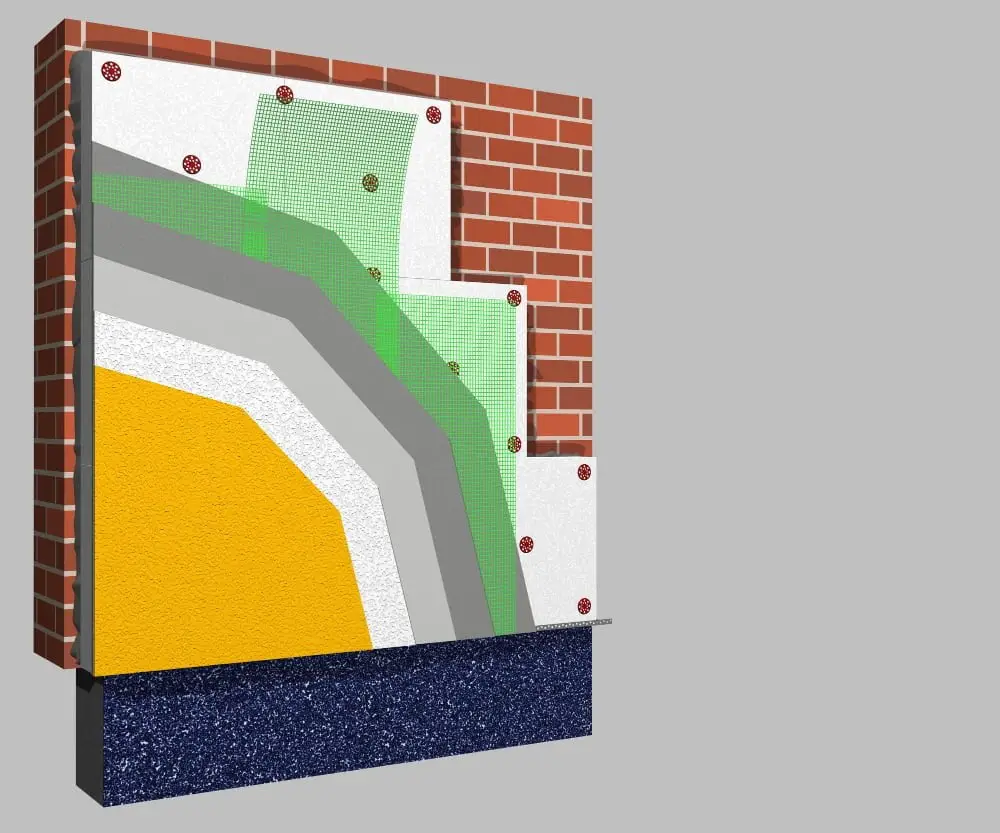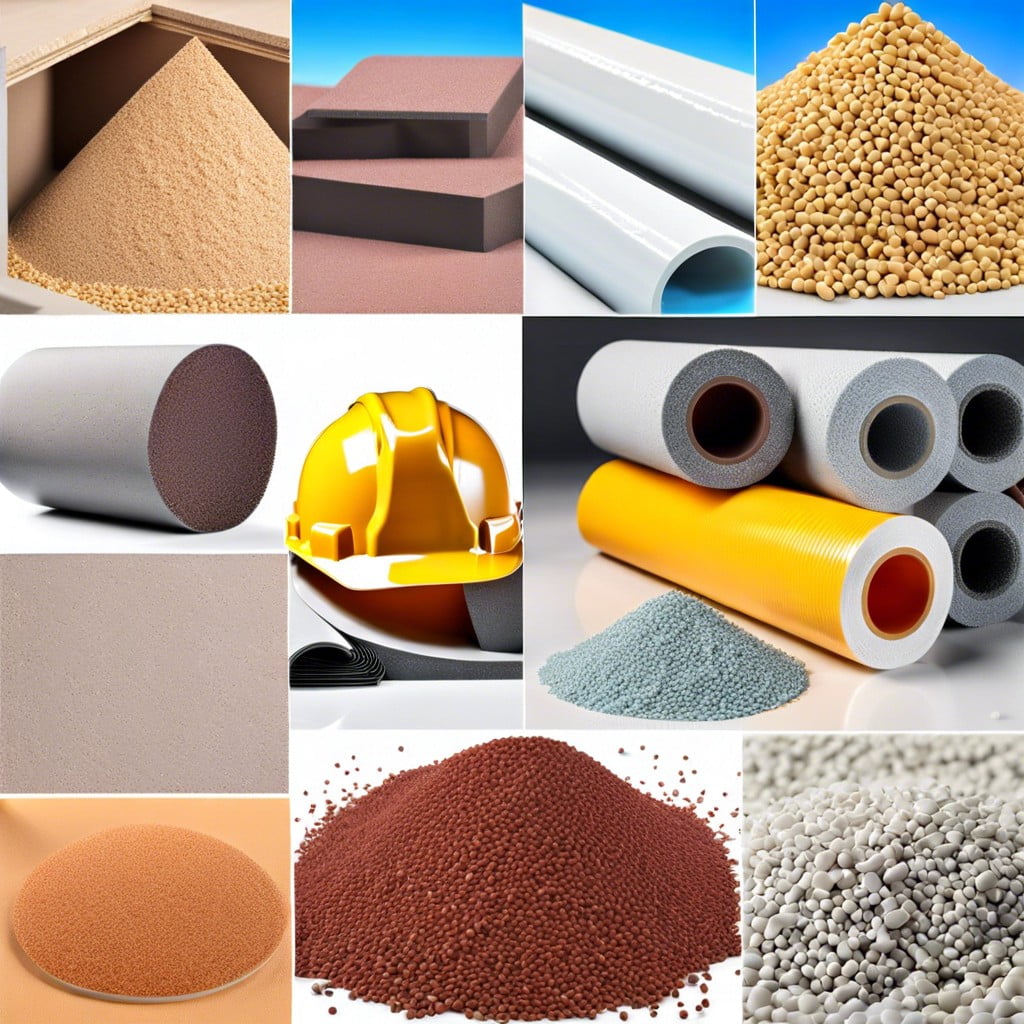Dive into the world of polymer engineering because it is revolutionizing the construction industry with innovative, durable, and sustainable materials.
Explore the intricate world of polymer engineering, a cornerstone in modern construction, where the design possibilities are as versatile as the molecules they’re built upon. Uncover how the molecular structure of polymers defines their interactions and paves the way for an array of materials ranging from the malleable thermoplastics to the robust, shape-retaining thermosets.
This article delves into the fascinating process of synthesis and polymerization, revealing how simple monomers transform into complex materials with targeted properties. You’ll get an insight into the advanced processing techniques that shape these polymers into innovative construction products, along with an understanding of the critical mechanical properties, such as tensile strength and elasticity, that make them indispensable in structural applications.
Discover the science that shapes our built environment through the lens of polymer engineering.
Key takeaways:
- Molecular Structure: Polymer properties depend on chain interactions and arrangement.
- Thermoplastics and Thermosets: Thermoplastics can be remolded, while thermosets set permanently.
- Synthesis and Polymerization: Monomers react to form polymers with specific properties.
- Processing Techniques: Different methods shape polymers for construction products.
- Mechanical Properties: Tensile strength and elasticity are important for structural use.
What You Will Learn
Polymer Engineering Fundamentals

Polymer engineering is the field that designs, analyzes, and modifies polymer materials to enhance performance in construction and other applications. It intersects with chemistry, physics, and other engineering disciplines to produce materials that meet specific structural requirements. Here’s a glimpse into the foundational concepts:
- Molecular Structure: Polymers are long chains of molecules, known as monomers, which determine the material’s properties. How these chains interact and are arranged can affect strength, flexibility, and durability.
- Thermoplastics and Thermosets: Thermoplastics soften upon heating and can be remolded, while thermosets irreversibly set when heated, providing enhanced stability.
- Synthesis and Polymerization: Creating polymers involves chemical reactions where monomers link to form chains. Controlling the reaction conditions allows engineers to tailor material properties.
- Processing Techniques: Various methods like extrusion, molding, and compounding shape polymers into final construction products. The process chosen impacts the material’s performance.
- Mechanical Properties: Understanding how polymers respond to forces is crucial. Tensile strength, elasticity, and compressibility must be aligned with their intended use in structures.
- Thermal Properties: Polymers’ response to temperature variations can affect their suitability in environments with fluctuating temperatures.
- Resistance to Chemicals and Weather: Polymers must resist degradation from chemicals and environmental factors – a key focus of polymer engineering.
Through these principles, polymer engineering provides innovative solutions to traditional construction challenges, offering materials that are lightweight, durable, and versatile.
Types of Polymers Used in Construction

Understanding the variety of polymers in the construction landscape is fundamental for their optimal application. Here are a few key categories based on their source and utility:
Natural Polymers: Elements like rubber, cellulose, and natural resins which are derived from plants and animals, are widely used. For instance, cellulose is a key ingredient in creating sustainable building insulation materials.
Thermoplastic Polymers: These are plastics that melt upon heating and solidify when cooled, making them moldable and recyclable. PVC (polyvinyl chloride) is a common example and is often used for pipes, windows, and roofing sheets.
Thermosetting Polymers: Unlike thermoplastics, these materials solidify permanently when heated and do not remelt. Epoxy and polyester resins fall into this category and are extensively used as adhesives or for the matrix in composite materials.
Elastomers: With their rubber-like properties, these materials can stretch and recover their original shape easily. Silicone sealants used for weatherproofing and expansion joint covers are practical examples.
Fibers: Synthetic fibers, such as nylon, polyester, and aramid, are crucial in reinforcing other materials to improve tensile strength. They are commonly found in various construction textiles and composite materials.
Each polymer type brings unique advantages to construction projects, from durability to flexibility, supporting innovative designs while ensuring building safety and efficiency.
Properties of Construction Polymers
Construction polymers boast an array of characteristics that make them well-suited for the rigors of the building industry.
Strength and durability: These materials can withstand substantial loads and resist wear, offering longevity to structures.
Resilience: They display an impressive ability to return to their original shape after bending, stretching, or compressing.
Lightweight: Their low density makes them easy to transport and handle, contributing to reduced foundation requirements and construction costs.
Thermal insulation: Polymers can effectively inhibit heat transfer, enhancing a building’s energy efficiency.
Corrosion resistance: Unlike metal, polymers do not rust or corrode from exposure to the elements, chemicals, or moisture.
Versatility: Available in various forms – from flexible films to rigid foams – polymers can be tailored to meet diverse construction needs.
Water resistance: They can provide effective barriers against moisture, guarding against leaks and water damage.
Each of these qualities can be tuned to specific needs by adjusting the polymer chemistry or by incorporating fillers and reinforcements, opening up a vast potential for customized solutions in construction.
Design and Synthesis of Construction Polymers
Polymers for construction are intentionally crafted to meet specific requirements, such as strength, flexibility, and durability. The process begins with understanding the desired characteristics for the application. From there, monomers—the building blocks of polymers—are chosen and synthesized to form macromolecules with tailored properties.
Tailoring Properties: By altering the molecular structure, chemists can enhance qualities such as tensile strength or UV resistance, making materials suitable for various construction needs, from insulation to load-bearing components.
Synthesis Techniques: Different polymerization methods are used to create construction polymers. For example, addition polymerization combines monomers without by-products, while condensation polymerization involves a chemical reaction that often releases a small molecule like water as a by-product.
Copolymerization: This process combines different types of monomers to create copolymers, granting the ability to incorporate the best properties of various monomers into one material.
Catalysts and Additives: Specific catalysts and additives can be introduced to control the reaction rate and molecular weight distribution, impacting the polymer’s final mechanical and thermal properties.
Prototyping and Testing: Before full-scale production, small batches of the polymer are produced to test and verify that the material meets the desired specifications. These steps ensure that construction polymers not only perform well but also maintain consistency and reliability in real-world applications.
Polymer Durability and Degradation
Polymers in construction must withstand diverse environmental conditions over time, influencing their lifespan and performance. Here are essential points on how durability is assessed and what leads to degradation:
- Resistance to Elements: Polymers are evaluated for their ability to resist water, UV radiation, and temperature changes. For instance, UV stabilizers can be added to improve resistance to sunlight.
- Chemical Stability: A polymer’s resilience to chemicals, such as acids or solvents, is crucial in environments where exposure is likely.
- Mechanical Stress: Polymers face stress from load-bearing applications. Their ability to recover from deformation without cracking defines their mechanical durability.
- Biodegradation: Some polymers are prone to breakdown by microorganisms, a process known as biodegradation, which can be advantageous or detrimental, depending on the application.
- Wear and Tear: Regular use can lead to abrasion and surface wear. Wear-resistant polymers or coatings can extend the material’s service life.
- Maintenance Needs: The requirement for maintenance, such as painting or sealing, can affect a polymer’s effective lifespan.
Understanding these factors helps in selecting the right polymers for construction, ensuring longevity and structural integrity.
Recycling and Sustainability of Construction Polymers
Construction polymers, due to their versatility and durability, play a critical role in the building industry. Yet, the sustainability of these materials is a hot topic, given environmental concerns.
Here’s a concise look into the recycling and sustainability aspects:
- Recyclable Materials: Many construction polymers can be recycled multiple times without significant loss of properties, reducing waste and conserving resources.
- Design for Disassembly: Buildings are designed with deconstruction in mind, allowing polymers to be reclaimed and repurposed at the end of their service life.
- Biopolymers: The use of biopolymers, derived from renewable resources, is on the rise. These materials are biodegradable and offer a greener alternative to traditional plastics.
- Energy Recovery: Non-recyclable polymers can be converted into energy through processes like pyrolysis, offering a secondary use after their service life.
- Lifecycle Assessment: This evaluates the environmental impact of polymers from production to disposal, guiding the selection of materials with lower carbon footprints.
- Green Certifications: Products with certifications like Cradle to Cradle demonstrate adherence to rigorous sustainability standards.
These strategies ensure that the use of polymers in construction aligns with environmental protection and resource conservation goals.
Innovation in Polymer Engineering for Construction
Polymer engineering has paved the way for groundbreaking materials that transform the construction industry. Innovations include:
- Self-healing polymers, which can repair small cracks or damages autonomously, thereby prolonging the lifespan of construction components.
- Smart polymer coatings that react to environmental stimuli, such as temperature and humidity, to offer dynamic insulation properties.
- Lightweight polymer composites that are reinforced with fibers, making them strong yet easy to handle, reducing structural weight and construction costs.
- 3D-printed polymer structures that enable complex architectural designs while minimizing waste during construction.
- Nanopolymers that enhance the properties of traditional construction materials, improving durability and resistance to environmental factors.
These advancements result in more efficient, sustainable, and durable construction methods, opening a realm of possibilities for future building designs.
Case Studies: Polymer Applications in Modern Construction
Polymers are revolutionizing the construction industry, offering a wide range of applications that improve durability, reduce weight, and enhance energy efficiency. Below are notable examples of how these versatile materials are put into action:
- Self-healing concrete: Concrete embedded with polymer microcapsules can repair cracks. When concrete cracks, the microcapsules break, releasing a polymer that hardens to fill the cracks.
- Insulation foams: Rigid polyurethane foams are used as insulation material in walls and roofs, significantly improving energy efficiency in buildings.
- Reflective roof coatings: These coatings, made from elastomeric polymers, reflect sunlight and provide waterproofing, reducing cooling costs by keeping buildings at a more constant temperature.
- Polymer composites in bridges: Fiber-reinforced polymer (FRP) composites are used for their high strength-to-weight ratio, making them ideal for bridge components that are easy to install and have extended lifespans with minimal maintenance.
- Plastic pipes: High-density polyethylene (HDPE) pipes resist corrosion, are lighter than traditional piping, and have a long service life, making them ideal for modern plumbing systems.
- 3D-printed building components: Advanced polymers are used in large-scale 3D printing to create complex architectural elements that can reduce construction time and waste.
Through these applications, polymers continue to provide innovative solutions, demonstrating their critical role in the future of construction.
Advancements in Polymer Composites for Structural Applications
Polymer composites, combining plastics with other materials like glass or carbon fibers, have revolutionized structural engineering. These composites offer enhanced strength, reduced weight, and increased durability over traditional construction materials.
Strength-to-Weight Ratio: Carbon fiber-reinforced polymers (CFRP), with a high-strength fibers embedded in a polymer matrix, provide exceptional strength while remaining lightweight. This is crucial for high-rise buildings and long-span bridges, where load-bearing capacity and reduced weight are paramount.
Corrosion Resistance: Unlike metal, polymers are naturally resistant to corrosion. This quality extends the life of structures, especially those exposed to harsh environments like coastal areas or chemical plants.
Design Flexibility: Polymers can be molded into complex shapes, allowing for innovative architectural designs. This flexibility also simplifies the integration of components for modular construction.
Thermal Insulation: Certain polymer composites have inherent thermal insulation properties. When used in walls, floors, or roofing systems, they contribute to energy efficiency by maintaining indoor temperatures.
Vibration Damping: Structures using polymer composites can absorb and dissipate energy from wind or seismic activities more effectively, reducing vibrations and increasing the safety and comfort of buildings.
Sustainability: With the development of bio-based polymers, composites can be produced from renewable resources. This reduces the carbon footprint of buildings and contributes to healthier ecosystems.
As these materials advance, so does their use in load-bearing components, facade elements, and entire structural systems, making them a cornerstone of modern construction technology.
Polymer Additives and Their Impact On Performance
Polymer additives play a pivotal role in enhancing material properties and extending the life span of polymer-based construction materials. These small yet effective compounds can drastically alter the performance of a base polymer, allowing for:
- Improved Durability: UV stabilizers protect against solar degradation, while antioxidants prevent damage from oxidative reactions.
- Enhanced Flexibility: Plasticizers lower the glass transition temperature of polymers, providing desired flexibility in applications like flooring and cable insulation.
- Increased Strength: Reinforcing fillers, such as glass fibers, impart robustness, making polymers suitable for load-bearing structures.
- Fire Resistance: Flame retardants can be added to reduce flammability and increase safety in building materials.
- Pest and Mold Resistance: Biocides deter mold growth and insect damage in wood-polymer composites used in outdoor constructions.
- Color Stability: Pigments and dyes maintain aesthetic appeal without compromising structural integrity.
By selecting the right combination of additives, engineers tailor polymers to meet specific construction challenges, opening up a myriad of possibilities for innovative building solutions.
Regulations and Standards in Construction Polymer Engineering
In the realm of construction, polymers must adhere to strict regulations and standards to ensure safety, performance, and environmental compliance. These regulatory frameworks define the essential criteria that polymer products should meet before they are integrated into building projects.
Key points to understand in this context include:
- Performance Codes: These codes stipulate the minimum performance requirements for polymers regarding strength, durability, and resistance to environmental factors like UV radiation and moisture.
- Building Codes: National and local building codes often include sections on the use of synthetic materials, specifying where and how polymers can be used structurally and non-structurally.
- Fire Safety Standards: Due to the potential flammability of certain polymers, they must pass fire safety tests that measure parameters like flame spread and smoke production.
- Environmental Regulations: With increasing focus on sustainability, polymers used in construction must often meet guidelines concerning their impact on indoor air quality and recyclability.
- Certifications: Independent certifications, such as LEED or the Euroclass system, provide third-party verification that polymers meet industry-recognized standards for environmental and health performance.
- Compliance Testing: Before market entry, polymer products are subjected to rigorous testing by accredited laboratories to ensure compliance with the relevant standards and regulations.
Staying updated on these critical points ensures that the application of polymers in construction is safe, efficient, and environmentally responsible.
Cost-Benefit Analysis of Polymer Materials in Construction
When assessing the value of using polymers in construction, several factors come into play. First and foremost, the initial cost may be higher than traditional materials, but polymers often provide long-term savings. This is due to their durability, requiring less maintenance and fewer repairs over the lifespan of a building.
Secondly, the lightweight nature of plastic materials can result in lower transportation and handling costs. It can also simplify the construction process, potentially shortening project timelines and reducing labor expenditures.
Third, energy efficiency is another pillar of the cost-benefit analysis. Polymers offer excellent insulation properties, which can lead to significant savings in heating and cooling expenses. Their ability to form tight seals can improve a building’s overall energy performance.
Lastly, the potential for recycling and reuse can both mitigate the disposal costs at the end of a product’s life cycle and contribute to a more sustainable construction model. This sustainable aspect is increasingly important, as many clients and regulations now demand eco-friendly construction practices.
In considering these points, stakeholders can make informed decisions about integrating polymers into their construction projects, balancing upfront investments against long-term advantages.
Future Trends in Polymer Engineering and Construction
Emerging trends in polymer engineering are set to revolutionize the construction industry:
1. Self-Healing Polymers: Researchers are developing materials that can autonomously repair cracks, which could significantly extend the lifespan of construction components and reduce maintenance costs.
2. 3D Printing with Polymers: Advancements in 3D printing technology allow for the creation of complex, custom shapes from polymer materials, offering unparalleled design freedom and on-site manufacturing possibilities.
3. Smart Polymers: Responsive polymers that can change their properties in reaction to environmental stimuli (like temperature or pH) are on the rise. These could be used to create adaptive building surfaces or structures that respond to changing weather conditions.
4. Nanopolymers: Incorporating nanoparticles can improve the strength, durability, and thermal performance of construction polymers without compromising weight, allowing for lighter and more energy-efficient structures.
5. Biopolymers in Construction: As the focus on sustainability intensifies, there’s an increasing interest in renewable biopolymers made from natural resources, which could reduce the carbon footprint of building materials.
6. Integration with Renewable Energy: The ability to integrate photovoltaic polymers into building materials could enable walls and windows that not only serve as structural elements but also generate electricity.
These cutting-edge developments promise not only to improve the performance of building materials but also to contribute to more sustainable, efficient, and innovative construction practices.
National Polymer Innovation Center
The National Polymer Innovation Center stands at the forefront of polymer research and development. Its primary focus is to foster breakthroughs in polymer technology that drive industry growth and address global challenges. Equipped with cutting-edge facilities, the center provides a collaborative environment where academia and industry intersect to innovate.
Key Points about the Center:
- State-of-the-Art Laboratories: The center boasts labs with advanced instrumentation for polymer synthesis, testing, and analysis, enabling researchers to push the boundaries of polymer science.
- Collaborative Projects: It acts as a hub for joint ventures between universities, government bodies, and private sector partners, facilitating the rapid transition from discovery to application.
- Educational Programs: It contributes to the field by educating the next generation of scientists and engineers through seminars, workshops, and hands-on research experiences.
- Economic Impact: By developing new polymer materials and processes, the center aids in creating job opportunities and promoting economic development within the industry.
- Innovation Incubator: The center is often likened to an incubator for polymer innovation, where novel ideas are nurtured and transformed into viable products and technologies.
By integrating resources and expertise, the National Polymer Innovation Center aims to catalyze advancements in polymer engineering with a long-lasting impact on the construction industry and beyond.
Collaborative Research
In the field of polymer engineering, collaborative research plays a crucial role in fostering innovation and solving complex issues. Such partnerships often involve universities, industry leaders, and government entities working together. This synergy allows for pooling resources, sharing expertise, and accelerating the development of new polymer materials and applications.
Cross-Disciplinary Expertise: Projects typically combine chemistry, material science, and civil engineering, to explore polymers’ potential in construction.
Shared Facilities: Partners may use laboratories with advanced equipment, creating economies of scale and reducing individual research costs.
Joint Funding Opportunities: Collaboration opens doors to larger grants which single entities may not access alone, bolstering robust research programs.
Real-World Application: Direct industry involvement ensures research remains relevant to market needs, allowing for immediate practical application of findings.
Knowledge Transfer: Students and researchers gain invaluable experience, while industry professionals stay abreast of cutting-edge academic advancements.
Graduate Programs in Polymer Science and Engineering
Graduate programs in Polymer Science and Engineering are designed to shape the next generation of experts in this field. These programs typically offer a Master of Science (M.S.) or Doctor of Philosophy (Ph.D.) degree, focusing on deepening the understanding of polymer materials, their applications, and processing techniques.
Here are some core aspects of these programs:
- Curriculum: Courses cover polymer chemistry, physics, and engineering principles, imparting knowledge about polymer synthesis, characterization, and the relationships between structure and properties.
- Research Opportunities: Students often participate in cutting-edge research, contributing to advancements in polymer technology and sustainability. Projects may range from developing new materials to optimizing processes for industrial applications.
- Laboratory Experience: Hands-on laboratory components are integral, allowing students to apply theoretical knowledge and gain practical skills in polymer processing and testing.
- Industry Connections: Many programs maintain close ties with the construction industry, enabling internships and cooperative education experiences that help students gain valuable professional exposure.
Thesis and Dissertation: Graduate students usually complete a research thesis or dissertation, which helps to develop critical thinking, problem-solving skills, and expertise in a specialized area of polymer science.
These graduate programs act as a springboard for careers in research and development, manufacturing, quality control, or academia, ensuring that students are well-equipped to meet the demands of the construction industry and beyond.
Research Opportunities for Students in Polymer Engineering
Engaging in research as a student in the field of polymer engineering can immensely enrich your educational experience and future career prospects. Here are a few avenues where students can delve into cutting-edge polymer research:
1. University Laboratories: Most universities with polymer programs offer research projects under the guidance of faculty members. These can range from synthesizing new polymers to testing their applications in various industries.
2. Industry Partnerships: Collaboration between academic institutions and industry often leads to research internships. These partnerships can provide insight into real-world polymer challenges and the business aspects of product development.
3. Government Research Grants: Agencies like the National Science Foundation (NSF) offer research grants that allow students to work on innovative polymer projects that could have societal impact.
4. Conferences and Symposia: Presenting findings at specialized gatherings can help in understanding current trends and networking with professionals.
5. Undergraduate Research Programs: Many schools have specific programs designed to integrate undergraduates into research, sometimes offering stipends or academic credit.
6. Online Research Journals: Participating in peer-reviewed journals by either submitting research or assisting in the review process can be invaluable for academic growth and recognition.
Each of these opportunities not only bolsters a resume but also provides hands-on experience in tackling real-world problems with polymer solutions.
Job Openings in the Field of Polymer Engineering
With a strong foundation in polymer engineering, numerous career opportunities beckon. Graduates may explore roles such as:
- Materials Engineer: Design, develop, and test materials used in buildings or infrastructure.
- Research Scientist: Innovate and study the properties of polymers, creating new materials for construction applications.
- Quality Control Technician: Ensure materials meet required standards and specifications for construction projects.
- Product Development Engineer: Work on creating polymer-based products, improving performance and sustainability.
- Sales Engineer: Combine technical knowledge with sales skills to provide clients with tailored construction polymer solutions.
- Environmental Engineer: Focus on developing eco-friendly polymer materials and processes.
Roles often require collaborating with architects, contractors, and civil engineers to integrate polymers into construction projects effectively. Opportunities for advancement include managerial positions or specialist roles in areas like composites or nano-materials. The evolving demands for sustainable and innovative construction materials guarantee a dynamic career landscape in polymer engineering.
SPE Scholarships for Polymer Engineering Students
SPE, the Society of Plastics Engineers, provides scholarships specifically aimed at supporting students pursuing careers in polymer engineering. These awards are valuable resources for easing the financial burden of education.
Here are key points to consider:
- Eligibility: Typically, these scholarships are available to undergraduate and graduate students enrolled in polymer science or engineering programs.
- Award Amounts: Scholarship amounts can vary, usually ranging from a few hundred to several thousand dollars.
- Application Process: Students must often submit transcripts, recommendation letters, and personal statements outlining their interests and career goals in polymer engineering.
- Selection Criteria: Awards are based on academic performance, potential for contribution to the polymer industry, and sometimes, research projects or extracurricular involvement.
- Deadlines: They are usually annual, with specific deadlines to apply each academic year. Students should check early to prepare their applications accordingly.
- Additional Benefits: Beyond monetary support, scholarship recipients may gain access to networking opportunities, mentorships, and SPE events which can be beneficial for professional development.
Students interested in such scholarships should reach out to their academic advisors or directly to SPE for the most current information on how to apply.
FAQ
What is the highest salary for polymer engineer?
The highest salary for a polymer engineer in India is ₹ 10.0 Lakhs per year.
Is Polymer Engineering the same as chemical engineering?
No, Polymer Engineering, focused on studying long chain molecules known as polymers, is not the same as Chemical Engineering, which concentrates on building machines used for extracting or refining chemicals.
What do you need to be a polymer engineer?
To become a polymer engineer, you typically need a bachelor’s degree in polymer science, materials engineering, or a related engineering field.
Is Polymer Engineering good?
Yes, Polymer Engineering is good as it offers diverse job opportunities in various sectors such as petrochemicals, packaging, sports, pharmaceuticals, perfumes, preservatives, and plastics, and has a scope for growth and innovation.
What are the various applications of polymers in construction?
Polymers in construction are used for applications such as thermal and acoustic insulation, water and moisture barriers, structural reinforcements, sealants, and in the production of paints, adhesives, and plastics.
What is the potential environmental impact of polymer use in construction?
The potential environmental impact of polymer use in construction can be significant, due to their long degradation time that contributes to waste accumulation, and their manufacturing process which often includes harmful emissions.
What are the latest advancements or innovations in polymer engineering relevant to construction?
The latest advancements in polymer engineering relevant to construction include self-healing polymers for concrete reinforcement, polymer composites for insulation applications, and smart polymers capable of adapting to environmental changes.
Related reading:





